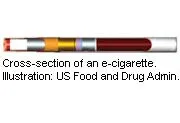Health experts say more research needed into the devices' safety and effectiveness as a quit-smoking tool
WebMD News from HealthDay

By Serena Gordon
HealthDay Reporter
FRIDAY, Jan. 3, 2014 (HealthDay News) -- It's the new year, a time when a smokers' thoughts often turn to quitting.
Some people may use that promise of a fresh start to trade their tobacco cigarettes for an electronic cigarette, a device that attempts to mimic the look and feel of a cigarette and often contains nicotine.
Here's what you need to know about e-cigarettes:
What is an e-cigarette?
The U.S. Food and Drug Administration (FDA) describes an e-cigarette as a battery-operated device that turns nicotine, flavorings and other chemicals into a vapor that can be inhaled. The ones that contain nicotine offer varying concentrations of nicotine. Most are designed to look like a tobacco cigarette, but some look like everyday objects, such as pens or USB drives, according to the FDA.
How does an e-cigarette work?
"Nicotine or flavorings are dissolved into propylene glycol usually, though it's hard to know for sure because they're not regulated," explained smoking cessation expert Dr. Gordon Strauss, founder of QuitGroups and a psychiatrist at Lenox Hill Hospital in New York City. "Then, when heated, you can inhale the vapor."
The process of using an e-cigarette is called "vaping" rather than smoking, according to Hilary Tindle, an assistant professor of medicine and director of the tobacco treatment service at the University of Pittsburgh Medical Center. She said that people who use electronic cigarettes are called "vapers" rather than smokers.
Although many e-cigarettes are designed to look like regular cigarettes, both Tindle and Strauss said they don't exactly replicate the smoking experience, particularly when it comes to the nicotine delivery. Most of the nicotine in e-cigarettes gets into the bloodstream through the soft tissue of your cheeks (buccal mucosa) instead of through your lungs, like it does with a tobacco cigarette.
"Nicotine from a regular cigarette gets to the brain much quicker, which may make them more addictive and satisfying," Strauss said.
Where can e-cigarettes be used?
"People want to use e-cigarettes anywhere they can't smoke," Strauss said. "I sat next to someone on a plane who was using an e-cigarette. He was using it to get nicotine during the flight." But he noted that just where it's OK to use an e-cigarette -- indoors, for instance? -- remains unclear.
Wherever they're used, though, he said it's unlikely that anyone would get more than a miniscule amount of nicotine secondhand from an e-cigarette.
Can an e-cigarette help people quit smoking?
That, too, seems to be an unanswered question. Tindle said that "it's too early to tell definitively that e-cigarettes can help people quit."
A study published in The Lancet in September was the first moderately sized, randomized and controlled trial of the use of e-cigarettes to quit smoking, she said. It compared nicotine-containing e-cigarettes to nicotine patches and to e-cigarettes that simply contained flavorings. The researchers found essentially no differences in the quit rates for the products after six months of use.
source : E-Cigarettes: Separating Fiction From Fact








